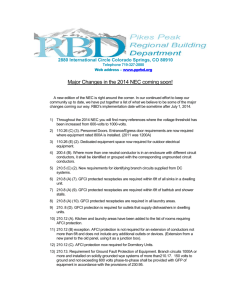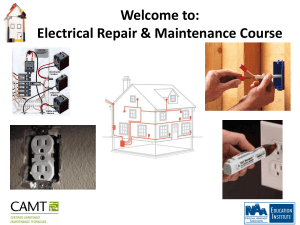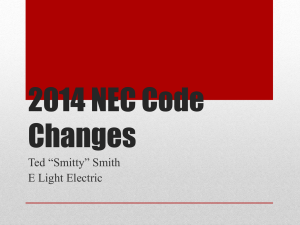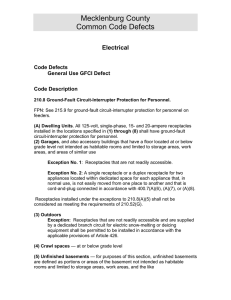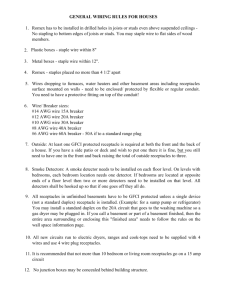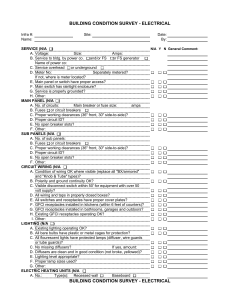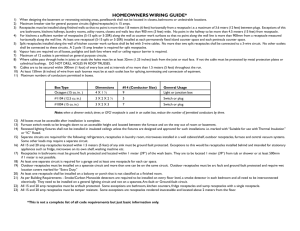Catching up with 2014 NC Electrical Code Updates from
advertisement
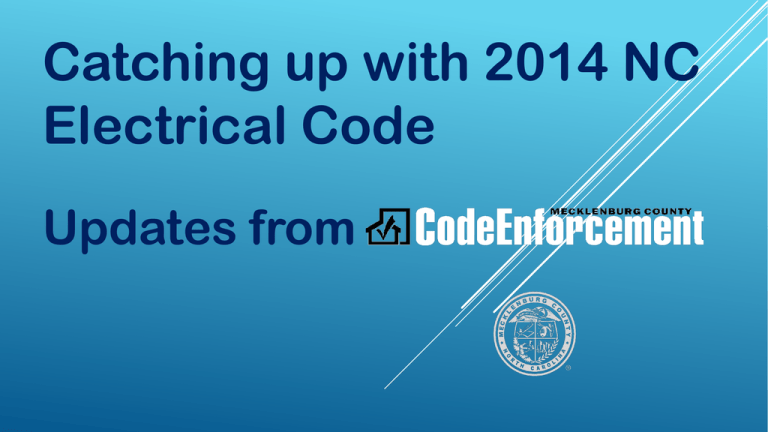
Catching up with 2014 NC
Electrical Code
Updates from
UTILITY TRANSFORMER POLICY
http://charmeck.org/mecklenburg/county/LUESA/CodeEnforcement/Inspe
ctions/trades/Electrical/Pages/Outdoor%20Utility%20Transformer.aspx
The 2014 NC Electrical Code went into effect on April 1st, 2016.
NCDOI: 13 Amendments
http://www.ncdoi.com/OSFM/Engineering_and_Codes/Documents/2014%20Edit
ion%20-%20Effective%20April%201%202016.pdf; 2014 NC Electrical Code
NFPA: http://www.nfpa.org/codes-and-standards/free-access ; 2014 NEC, 2014
TIAs, 2014 Errata –
•
8 TIAs
•
64 Errata
Item 6.1: Retain language from 2011 NEC for 110.26
(E) (2) – No Cost Impact (NEW AMENDMENT)
AMENDMENT 110.26(E)(2)
Amend NEC 2014, page 41:
(2) Outdoor.
(a) Installation Requirements. Outdoor electrical equipment shall be
installed in suitable enclosures and shall be protected from accidental
contact by unauthorized personnel, or by vehicular traffic, or by
accidental spillage or leakage from piping systems. The working
clearance space shall include the zone described in 110.26(A). No
architectural appurtenance or other equipment shall be located in this
zone.
(b) Deleted.
Item 6.2: Retain Existing NC Electrical Code Amendment to 210.8(A)
(3) – No Cost Impact
Amend NEC 2014, page 54:
(3) Outdoors
Exception No. 1 to (3): Receptacles that are not readily accessible
and are supplied by a branch circuit dedicated to electric snowmelting, deicing, or pipeline and vessel heating equipment shall be
permitted to be installed in accordance with 426.28 or 427.22, as
applicable.
Exception No. 2 to (3): A single outlet receptacle supplied by
dedicated branch circuit which is located and identified for specific
use by a sewage lift pump.
Item 6.3: Retain language from 2011 NEC for
210.8(A) (7) {residential GFCI requirements} – No
Cost Impact (NEW AMENDMENT)
AMENDMENT 210.8(A)(7)
Amend NEC 2014, page 54:
(7) Sinks — located in areas other than kitchens where receptacles
are installed within 1.8 m (6 ft.) of the outside edge of the sink.
Item 6.4: Remove GFCI requirement for
kitchen dishwasher branch circuit. This was
not a requirement in the 2011 NEC. – No Cost
Impact (NEW AMENDMENT)
AMENDMENT 210.8(D)
Amend NEC 2014, page 55:
210.8(D) Kitchen Dishwasher Branch Circuit. Deleted
Item 6.5: Retain location requirements from 2011 NEC for
AFCI Protection and remove term “readily”. – No Cost
Impact (NEW AMENDMENT)
Amend NEC 2014, page 56: (no kitchen or laundry requirement)
210.12 Arc-Fault Circuit-Interrupter Protection. Arc-fault circuitinterrupter protection shall be provided as required in 210.12(A) (B),
and (C). The arc-fault circuit interrupter shall be installed in an
accessible location.
(A) Dwelling Units. All 120-volt, single-phase, 15- and 20-ampere
branch circuits supplying outlets or devices installed in dwelling unit
family rooms, dining rooms, living rooms, parlors, libraries, dens,
bedrooms, sunrooms, recreation rooms, closets, hallways, or similar
rooms or areas shall be protected by any of the means described in
210.12(A)(1) through (6):
Item 6.7: Revise to reflect NC Electrical Code Amendment
with January 1, 2015 effective date. - No Cost Impact (NO
CHANGE)
Amend NEC 2014, page 62:
210.52 (I) Foyers. Foyers that are not part of a hallway in
accordance with 210.52(H) and that have an area that is greater
than 5.6 m2 (60 ft2) shall have at least one receptacle.
Item 6.8: Retain Existing NC Electrical Code Amendment to
250.50 – No Cost Impact (NO CHANGE)
Amend NEC 2014, page 117:
250.50 Grounding Electrode System. All grounding electrodes as described in
250.52(A)(1) through (A)(7) that are available at each building or structure served
shall be bonded together to form the grounding electrode system. Where none of
these grounding electrodes exist, one or more of the grounding electrodes
specified in 250.52(A)(4) through (A)(8) shall be installed and used.
Item 6.9: Modify 250.53 (A) (2) to match D-1 Agenda Item
– No Cost Impact (NO CHANGE)
Amend NEC 2014, page 118:
(2) Supplemental Electrode Required.
Exception No. 1: If a single, rod, pipe, or plate grounding electrode
has a resistance to earth of 25 ohms or less, the supplemental
electrode shall not be required.
Exception No. 2: The supplemental ground electrode shall not be
required at temporary electrical service installation (saw service
pole) at a construction site for one and two-family residences,
provided the temporary electrical service does not exceed 150
volts to ground or 100A.
Item 6.10: Retain Table and Language of 2011 NEC related to sizing of Dwelling
Services and Feeders – No Cost Impact (NEW AMENDMENT)
AMENDMENT 310.15(B)(7)
Amend NEC 2014, page 160:
(7) 120/240-Volt, 3-Wire, Single-Phase Dwelling Services and Feeders.
For individual dwelling units of one-family, two-family, and multifamily
dwellings, conductors, as listed in Table 310.15(B)(7), shall be permitted as
120/240-volt, 3-wire, single-phase service-entrance conductors, service-lateral
conductors, and feeder conductors that serve as the main power feeder to
each dwelling unit and are installed in raceway or cable with or without an
equipment grounding conductor. For application of this section, the main
power feeder shall be the feeder between the main disconnect and the
panelboard that supplies, either by branch circuits or by feeders, or both, all
loads that are part of or associated with the dwelling unit. The feeder
conductors to a dwelling unit shall not be required to have an allowable
ampacity rating greater than their service-entrance conductors. The
grounded conductor shall be permitted to be smaller than the ungrounded
conductors, provided the requirements of 215.2, 220.61, and 230.42 are met.
Table 310.15(B)(7) Conductor Types and Sizes for
120/240-Volt, 3-Wire, Single-Phase Dwelling Services and Feeders. Conductor
Types RHH, RHW, RHW-2, THHN, THHW, THW, THW-2, THWN, THWN-2, XHHW,
XHHW-2, SE, USE, USE-2
Service or
Feeder
Rating
(Amperes)
Copper
Aluminum
or
CopperClad
Aluminu
m
100
4
2
110
3
1
125
2
1/0
150
1
2/0
175
1/0
3/0
200
2/0
4/0
225
3/0
250
250
4/0
300
300
250
350
350
350
500
400
400
600
Item 6.11: Retain Existing NC Electrical Code Amendment
to 334.15 (C) – No Cost Impact (NO CHANGE)
Amend NEC 2014, page 204:
(C) In Unfinished Basements. Where cable is run at angles with joist in
unfinished basements it shall be permissible to secure cables not smaller than
two 6 AWG or three 8 AWG conductors directly to the lower edges of the
joists. Smaller cables shall be run either through bored holes in joists or on
running boards. Nonmetallic-sheathed cable installed on the wall of an
unfinished basement shall be permitted to be installed in a listed conduit or
tubing or shall be protected in accordance with 300.4. Conduit or tubing shall
be provided with an insulating bushing or adapter at the point the cable
enters the raceway. The sheath of the nonmetallic-sheathed cable sheath
shall extend through the conduit or tubing and into the outlet or device box
not less than 6 mm (1/4 in.). The cable shall be secured within 300 mm (12 in.)
of the point where the cable enters the conduit or tubing. Metal conduit,
tubing, and metal outlet boxes shall be connected to an equipment
grounding conductor complying with the provisions of 250.86 and 250.148.
Item 6.12: Revise to reflect NC Electrical Code Amendment with January 1,
2015 effective date. – No Cost Impact (NO CHANGE)
AMENDMENT 404.2(C)(8)
(grounded conductor at switches)
Amend NEC 2014, page 278:
(8) Where installed in residential one- and two- family dwellings.
Item 6.13: Remove term “readily” from 406.4 (D) and add new exception – No
Cost Impact (NEW AMENDMENT)
Amend NEC 2014, page 282:
(D) Replacements. Replacement of receptacles shall comply with 406.4(D)(1)
through (D)(6), as applicable. Arc-fault circuit-interrupter type and ground-fault
circuit-interrupter type receptacles shall be installed in an accessible location.
(4) Arc-Fault Circuit-Interrupter Protection. Where a receptacle
outlet is supplied by a branch circuit that requires arc-fault circuitinterrupter protection as specified elsewhere in this Code, a
replacement receptacle at this outlet shall be one of the following:
(1) A listed outlet branch-circuit type arc-fault circuit-interrupter
receptacle
(2) A receptacle protected by a listed outlet branch-circuit type
arc-fault circuit-interrupter type receptacle
(3) A receptacle protected by a listed combination type arc-fault
circuit-interrupter type circuit breaker
This requirement becomes effective January 1, 2014.
Exception: Non-grounding type receptacles.
Item 6.14: For one- and two-family residences, remove term
“readily” from 422.5 – No Cost Impact (NEW AMENDMENT)
Amend NEC 2014, page 303:
422.5 Ground-Fault Circuit-Interrupter (GFCI) Protection. The device
providing GFCI protection required in this article shall be readily
accessible.
Exception: For one- and two-family residences, the device providing
the GFCI protection required in this article shall be accessible.
CODE WIDE CHANGES
There
were approximately 3,745 proposals and 1,625 public comments
submitted for modifications to the 2014 edition of the NEC.
Field-Applied
Hazard Markings. 110.21(B) was added to include
specific requirements for warning labels and similar markings where
required or specified elsewhere in the Code.
Lockable
Disconnecting Means. New 110.25 was added to deliver a
“one-stop” location providing consistent requirements for a lockable
disconnecting means.
Requirements
for dc Systems Integrated Throughout NEC. Direct current
(dc) applications are experiencing a re-emergence because of such
things as electric vehicle charging, solar photovoltaic (PV) systems,
microgrids, wind-generated electric systems, etc.
“Switchgear”
Incorporated Throughout the NEC. The previous definition for
“Metal-Enclosed Power Switchgear” was modified and retitled to simply
“Switchgear” to make it inclusive of all types of switchgear under the purview
of the NEC.
Definitions
Relocated to Article 100. Several existing definitions which
appeared in the definitions of a particular article have been relocated to
Article 100 as these terms are also found in other articles, not just the article
where the previous definition was located.
600
Volts to 1000 Volts. Numerous changes throughout the NEC from the 600
volts threshold to 1000 volts.
New
Articles. Four new articles added to the 2014 NEC.
CODE-WIDE CHANGES (CONT.)
210.5(C)(2) Branch Circuits Supplied From Direct Current Systems
New branch circuit identification requirements added for dc
systems.
For sizes 6 AWG and smaller, red for positive dc conductors and
black for negative dc conductors.
For branch circuits supplied from a dc system operating at more
than 50 volts, each ungrounded conductor of 4 AWG or larger is
to be identified by polarity at all termination, connection, and
splice points by marking tape, tagging, or other approved
means.
Direct current (dc) applications are experiencing a reemergence in the electrical industry because of such things as
electric vehicle charging, solar photovoltaic (PV) systems,
microgrids, wind generated electric systems, etc.
NEC 210.8(A)(7) GFCI: Dwelling Unit Sinks
GFCI protection required for all 125-volt, single-phase, 15- and 20ampere receptacles installed within 1.8 m (6 ft) of all dwelling unit
sinks (including kitchen sinks). Revision removes the term “located in
areas other than kitchens.” Rule will now include the garbage
disposal receptacle located in the cabinet under a kitchen sink,
receptacle located behind a refrigerator, or a general lighting
branch circuit living room receptacle located on the back side of a
kitchen sink bar area if they are located within 1.8 m (6 ft) of the
kitchen sink.
NC 210.8(A) (7) Sinks — located in areas other than kitchens where
receptacles are installed within 1.8 m (6 ft) of the outside edge of
the sink.
NEC 210.8(D) Dwelling Unit Kitchen Dishwasher Branch Circuit
GFCI protection now required for all outlets that supply dishwashers installed in dwelling units.
Includes both receptacle and hard-wired outlet for dishwasher.
Modern-day electronically controlled dishwashers can experience “end of life” failures that can result
in increased risk of electrical shock.
GFCI protection for outlets supplying dishwashers can mitigate these increased risk of electrical shock.
NC Item 6.4: Remove GFCI requirement for kitchen
dishwasher branch circuit. This was not a requirement in the
2011 NEC. – No Cost Impact (NEW AMENDMENT)
210.8 (D) Kitchen Dishwasher Branch Circuit. GFCI protection
shall be provided for outlets that supply dishwashers installed in
dwelling unit locations.
210.8(A)(9) Dwelling Unit Bathtubs or Shower Stalls
GFCI protection now required where receptacles are installed within 1.8 m (6
ft) of the outside edge of dwelling unit “Bathtubs or Shower Stalls.”
Bathtubs or shower stalls are not always located in an area that meets the
Article 100 definition of a “bathroom.”
Bathroom is “an area including a basin with one or more of the following: a
toilet, a urinal, a tub, a shower, a bidet, or similar plumbing fixtures.”
Example: a room or area connected to a dwelling unit bedroom with a
bathtub or shower stall as the only plumbing fixture in that particular room or
area with a basin sink and toilet provided in another common area of the
dwelling.
210.8(A)(10) GFCI: Laundry Areas
All dwelling unit “Laundry Areas” now require GFCI protection for
125-volt, single phase, 15-and 20-ampere receptacles (regardless
of presence of a sink or distance from same).
A laundry room sink is no longer the driving factor whether GFCI
protection is required or not.
GFCI protection in laundry areas addresses increased shock
hazard risk and is consistent with other NEC requirements for GFCI
protection of receptacles in areas in close proximity of water.
Increased usage of GFCI protection for personnel at receptacles
of residential homes is a highly effective means of further reducing
the potential for electrical shock hazards.
NEC 210.12 AFCI Protection
New provision added to require all AFCI devices required by 210.12 to be installed in a readily accessible
location. Aligns with the “readily accessible” requirements for GFCI devices covered at 210.8. Primarily
related to occupant or user accessibility to the monthly testing and reset features of AFCI devices. Will aid
and facilitate the ability to reset the AFCI device in the event the AFCI detects an arcing event.
NC Item 6.5: Retain location requirements from 2011 NEC for AFCI
Protection and remove term “readily”. – No Cost Impact (NEW
AMENDMENT)
210.12 Arc-Fault Circuit-Interrupter Protection. Arc-fault circuit-interrupter
protection shall be provided as required in 210.12(A) (B), and (C). The arc-fault
circuit interrupter shall be installed in an readily accessible location.
(A) Dwelling Units. All 120-volt, single-phase, 15- and 20-ampere branch
circuits supplying outlets or devices installed in dwelling unit, kitchens, family
rooms, dining rooms, living rooms, parlors, libraries, dens, bedrooms,
sunrooms, recreation rooms, closets, hallways, laundry areas, or similar rooms
or areas shall be protected by any of the means described in 210.12(A)(1)
through (6):
210.12(A)(1) – (6) AFCI Protection
AFCI protection methods were expanded and language put into
a list format.
Provisions for outlet branch circuit (OBC) AFCI devices were
expanded.
The first two previous exceptions were revised to positive
language and put into a list format of six provisions for providing
AFCI protection.
210.12(B) Ex. Branch Circuit Extensions or Modifications Dwelling Units
Existing branch circuit conductors can be extended up to 1.8 m (6
ft.) without AFCI protection where no additional outlets or devices
are installed for when modified or extended.
Examples where situation does not require an AFCI device to be
installed:
Extending branch circuit conductors within an enclosure for the
purposes of replacing a device or utilization equipment.
Extending a branch circuit a short distance to a panelboard being
replaced or upgraded.
210.17 ELECTRIC VEHICLE BRANCH CIRCUIT
Outlet(s)
installed for the purpose of charging electric vehicles
required to be supplied by a separate branch circuit with no
other outlets.
Charging
an electric vehicle (EV) with an existing 120 volt
receptacle outlet will typically overload an existing general
purpose branch circuit.
It
should be noted that this new requirement does not demand
that an outlet(s) for the specific and sole purpose of charging EV
equipment be installed.
A
new I-Note was also added giving guidance to 625.2 for the
definition of an “Electric Vehicle.”
210.52(E)(1) AND (E)(2) OUTDOOR OUTLETS
The
requirements for outdoor receptacles at dwellings have
been revised to permit the required receptacle outlets to be
“readily accessible from grade.”
This
provision was revised by removing the “while standing at
grade level” requirement.
This
change will allow the deck or porch receptacle outlet to
serve as one of the required outdoor receptacle outlets if it is
“readily accessible from grade” with the deck or porch
permitted to serve as “grade.”
Same
revision to individual units of multifamily dwellings (with
individual exterior entrance/egress).
210.52(E)(3) BALCONIES, DECKS AND PORCHES
The
requirement for a receptacle located at “Balconies, Decks,
and Porches” has been revised to require the balcony, deck or
porch to be attached to the dwelling.
Requirements
for the outdoor receptacle outlet to be installed
“within the perimeter” of the balcony, deck or porch have been
eliminated.
“Detached”
decks and such do not pose the same threat of
extension cords being ran through windows and doorways as
their “attached” counterparts.
210.52(G) BASEMENTS, GARAGES, AND ACCESSORY BUILDINGS
“Basements,
Garages, and Accessory Buildings” receptacle provisions
revised into list format.
210.52(G)(1)
Garages
210.52(G)(2)
Accessory Buildings
201.52(G)(3)
Basements
Branch
circuit supplying garage receptacle(s) to supply only the garage.
Receptacle
This
required for each car space in a garage.
is an effort to recognize the possibility of electric vehicle (EV) and plugin hybrid electric vehicle (PHEV) charging in these garages.
Table 220.3 Additional Load Calculation
References
New line item added to Table 220.3 for “Electric Vehicle
Charging Equipment” and a reference to 625.14.
This will help clarify the load calculation requirements
for electric vehicle (EV) charging loads (considered as
continuous).
Electric vehicles and their charging stations are a
growing trend in the electrical industry.
This will give a direct and necessary link from Article 220
(calculations) to Article 625 for EV charging systems.
225.36 TYPE
Disconnect type has been rewritten
Now only required to be service rated if used
where applied with 250.32 (B) Exception No. 1
All others do not require service rating
230.30 Installation and Wiring Methods (Underground
Service Conductors)
230.30 was divided into two subsections:
(A) “Insulation”
(B) “Wiring Methods”
List of acceptable wiring methods for “Underground Service
Conductors” was added.
List includes all the cables and conductors that are identified in
Chapter 3 as suitable for use as both service conductors and for
direct burial.
This section is referring to the conductors from the service point to
the service disconnecting means, which is the definition of
“Service Conductors.”
Table 250.102(C) Sizing Grounded Conductors, Main
Bonding Jumpers, Etc.
New Table 250.102(C) added for sizing grounded conductors,
main bonding jumpers, system-bonding jumpers, and supplyside bonding jumpers (rather than Table 250.66).
References to this new table were revised throughout Article
250.
Table 250.66 is titled for GECs with a max. required conductor of
3/0 copper or 250 kcmil aluminum.
Table 250.122 will continue to be used for sizing fault-return
carrying conductors, such as equipment grounding conductors,
if the supply conductors have overcurrent protection on the
supply side.
250.130(C) Nongrounding Receptacle Replacement or
Branch Circuit Extensions
Connection to an equipment grounding conductor that is part of another
branch circuit that originates from the enclosure where the branch circuit for
the receptacle or branch circuit originates is permitted for replacement of
non-grounding-type receptacles with grounding-type receptacles and for
branch-circuit extensions.
This is simply an extension of the present list item (3) that allows connecting to
the equipment grounding terminal bar in the related panelboard.
Allowing a connection back to the same enclosure or panelboard that serves
the receptacle branch circuit will typically provide a shorter, more effective
equipment grounding or ground-fault return path.
250.167 Direct-Current Ground-Fault Detection
New section added for “Direct-Current Ground-Fault Detection”
requiring ground-fault detection on dc ungrounded systems.
New requirements address grounded systems, ungrounded
systems, and marking rules for each.
These new provisions require ground-fault detection for
ungrounded dc systems and permits ground-fault detection for
grounded dc systems.
New marking requirements call for system to be legibly marked
to indicate the type of grounding provisions provided at the dc
source or the first disconnecting means of the dc system.
Table 310.15(B)(3)(a) More Than Three Current-Carrying
Conductors
Title
of 310.15(B)(3)(a) and corresponding table was changed to
“More Than Three Current-Carrying Conductors in a Raceway or
Cable.”
Note
to Table 310.15(B)(3)(a) was revised to make it clear that
table applies to spare conductors but does not apply to
conductors that cannot be simultaneously energized.
Ampacity
adjustment correction factor is required for three or
more current carrying conductors that are installed or bundled
together without maintaining spacing as well as those in a
raceway or cable.
314.15 Damp or Wet Locations
All “outlet box hood” covers are required to be listed for use in a
wet location, not just “extra duty” outlet box hood covers installed
in a wet locations.
The term “outlet box hoods” was added at this section, making
boxes, conduit bodies, outlet box hoods, and fittings installed in
wet locations to now be required to be listed for use in wet
locations.
Previous language at 406.9(B)(1) required “extra duty” outlet box
hoods installed in a wet location to be listed for use in a wet
location.
314.15 only required boxes, conduit bodies, and fittings installed in
wet locations to be listed for use in wet locations.
314.25 Covers and Canopies
Drywall screws are not permitted to be used to attach box
covers or other equipment fastened to a box.
Screws used for this purpose are now required to be either
machine screws matching the thread gauge or of a size that is
integral to the box (in accordance with the manufacturer’s
instructions).
The use of drywall screws is unacceptable and can result in
damage to the box and inadequate support of the attached
luminaire or equipment itself.
Similar provisions have been introduced at 404.10(B) for
mounting of switches and 406.5 for mounting of receptacles.
314.15 Damp or Wet Locations
Approved drainage openings permitted to be installed
in the field in boxes or conduit bodies listed for use in
damp or wet locations in accordance with
manufacturer’s instructions.
These weep holes cannot be larger than 6 mm (1/4 in.).
Weep holes in the bottom of boxes installed in wet
locations improves the safety and durability of electrical
installations.
Without these weep holes, the inside of cast aluminum
boxes and other metallic enclosures can degrade over
time due to moisture condensation.
314.27(A)(1) Vertical Surface Luminaire Outlets
The title was changed from “Wall Outlets” to “Vertical Surface
Outlets” as not all vertical surfaces where luminaire or
lampholders are mounted are necessarily in or on a “wall.”
New language was also added to reflect that luminaires or
lampholders can be mounted “on” a vertical service as well as
“in” a vertical service.
The previous language only addressed boxes mounted “in a
wall.”
An example of a “vertical” surface-mounted luminaire would be
a luminaire mounted on the side of a square post in the middle
of a large room or area.
314.27(A)(2) Boxes at Ceiling-Mounted Luminaire Outlets
Outlet boxes used to support ceiling-mounted luminaires that
weigh more than 23 kg (50 lb.) are now required to be marked
with the maximum weight the box will support on the “interior of
the box.”
Allows the installer and the electrical inspector an opportunity to
review this information at the time of installation without having to
climb into the attic to retrieve this information.
In some cases, the exterior of the outlet box is not accessible
after a certain point in the building construction process.
Ceiling-mounted outlet box supporting a luminaire weighing
more than 23 kg (50 lb.) is required to be listed and marked for
the maximum weight that particular outlet box is designed to
support.
334.40(B) Devices of Insulating Material (Type NM Cable)
Nonmetallic-sheathed cable interconnectors have been
recognized to be used without a box and concealed where
used for “repair wiring” rather than “rewiring” in existing
buildings.
Listed “nonmetallic sheathed cable interconnector devices”
replaces the term “tap devices” to zero in on the specific type of
device permitted in this application.
When using Type NM cable, 300.15 generally requires a box to
be installed at each conductor splice point, outlet point, switch
point, junction point, termination point, or pull point.
Type NM cable interconnectors are insulating enclosures which
when connected to Type NM cable form both a mechanical
and electrical connection.
334.40(B) DEVICES OF INSULATING MATERIAL (TYPE NM
CABLE) (CONT.)
Further revision made a clear distinction between “rewiring”
and “repair wiring” in existing buildings.
Rewire is typically defined as replacing existing wiring with new
wiring.
If an electrician has the accessibility and availability to replace
existing wiring with new wiring, there would be no need for a
device such as a nonmetallic-sheathed cable interconnector.
“Repair wiring” seems to be justified for the application of a
nonmetallic-sheathed cable interconnector.
An example of an area where these concealed nonmetallicsheathed cable interconnectors might be used would be in
flooded areas.
Article 393 Low Voltage Suspended Ceiling Power
Distribution Systems
A new article was added to address low-voltage Class 2 ac and dc volt
supplied equipment (lighting and power) connected to ceiling grids,
floors and walls built for this purpose.
New article addresses equipment with similar features to track lighting but
includes the wiring and power supply requirements.
New article provides specific requirements for safe installations of low
voltage, power limited power distribution, for power to lighting and nonlighting loads.
The growing interest in alternative energy sources (e.g. PV, wind turbines,
batteries, fuel cells, etc.) and the increase of low voltage, low power
devices (sensors, LV lighting, IT equipment, AV equipment, etc.), has
created a significant need this new article.
400.7(A)(11) USES PERMITTED (FLEXIBLE CORDS AND
CABLES)
A
flexible cord between an existing receptacle outlet and an
inlet, where the inlet provides power to an additional single
receptacle outlet as a listed assembly is now permitted.
Wiring
interconnecting the inlet to the single receptacle outlet to
be a Chapter 3 wiring method.
The
inlet, receptacle outlet, and Chapter 3 wiring method,
including the flexible cord and fittings, must be a “listed
assembly” specific for this application.
Primarily
used for flat-screen televisions mounted on a wall.
404.2(C) GROUNDED CONDUCTOR AT SWITCH
LOCATIONS
NEC has lots of changes but –
NC Amendment- (8) Where installed in
residential one- and two- family dwellings.
Does not apply in NC
404.8(C) MULTIPOLE SNAP SWITCHES
Multipole snap switches rated not less than the system voltage
(whether listed for multiple circuits or not) are no longer permitted
to be fed from more than a single circuit.
Multipole, general-use snap switches listed and marked as a twocircuit or three-circuit switch are still permitted to be fed from more
than a single circuit.
Previous language allowed a general use multi-pole snap switch to
be used for multi-circuit applications.
Listed 2- and 3-pole general use snap switches have not been
evaluated for use in multi-circuit applications.
There are different listing requirements for 2- and 3-pole snap
switches and 2- and 3-pole multi-circuit switches.
406.3(E) AND FIGURE 406.3(E) CONTROLLED
RECEPTACLE MARKING
New marking symbol for receptacle outlets controlled by an automatic control device or
by an automatic energy management system was added at 406.3(E).
New Figure 406.3(E) was also added displaying
new “Controlled Receptacle Marking” symbol.
New exception added to indicate that this marking is not required for receptacle outlets
controlled by a wall switch to provide the required room lighting outlet(s) as permitted by
210.70(A)(1) Ex. No. 1.
The occupant or end user needs to know which receptacle outlets will be automatically
controlled and which receptacles will be energized continually.
It is important to be able to readily identify receptacle outlets that will be automatically
powered on and off.
406.4(D) REPLACEMENT RECEPTACLES
Arc-fault circuit-interrupter (AFCI) and ground-fault circuit-interrupter (GFCI)
type receptacles installed for replacement receptacles required to be
installed in a readily accessible location.
Initiated to align the “readily accessible” requirements for GFCI devices stated
at 210.8.
Primarily related to occupant or user accessibility to the monthly testing and
access to the reset features of the device.
It should be noted that this “readily accessible” requirement only pertains to
AFCI and GFCI outlet devices used for replacement of existing receptacles
due to its placement at 406.4(D).
NC
AMENDMENT- in an accessible location.
NC also has added an exclusion for the AFCI protection of 406.4 (D) (4),
Exception: Non-grounding type receptacles.
406.5(E) RECEPTACLES IN COUNTERTOPS
AND SIMILAR WORK SURFACES
The
term “in Dwelling Units” was removed from the title to make
it clear that receptacles cannot be installed in a face-up
position of any type occupancy (not just dwelling units).
Concern
about receptacles installed in the “face-up” position
for such things as liquid spillage exist at countertops or similar
work surfaces of non-dwelling units as well dwelling units.
Listed
receptacle assemblies for countertop applications have
been recognized for this application as well.
Per
NCDOI they have to be hardwired to count as the required
outlets.
406.5(F) RECEPTACLES IN SEATING
AREAS AND OTHER SIMILAR SURFACES
New provisions added which prohibits receptacles from being
installed in a “face-up” position in seating areas or similar
surfaces unless they are part of an assembly listed for the
application.
Benches and seating areas in public locations such as airports
are being installed with receptacles installed in and on the
seating areas (some in the face-up position).
Where there is a need to install such receptacles in benches
or other similar surfaces, it should be done with an assembly
listed for the application to prevent damage and potential
exposure to energized conductors or circuit parts.
406.9(B)(1) 15- and 20-Ampere Receptacles in a Wet
Location
“Extra duty” covers are now required for all 15- and 20-ampere, 125- and
250-volt receptacles installed in a wet location (not just those supported
from grade).
If the receptacle is installed in a wet location, it should make no difference
how the enclosure or device box is installed or supported when determining
the need for an extra duty hood cover.
This requirement now also includes dwelling unit wet location receptacles as
well.
The durability of the nonmetallic in-use cover hoods provided for
compliance with these wet location requirements has been found to be less
than desirable, especially on construction sites.
406.15 Dimmer Controlled Receptacles
Dimmer-controlled receptacles now permitted for a plug/receptacle
combination in listed nonstandard configuration types.
A receptacle supplying lighting loads can be connected to a dimmer if the
plug/receptacle combination is a nonstandard configuration type and
specifically listed and identified for each such unique combination.
120 volt cord-and-plug connected lighting such as rope lighting is typically
being installed under shelving or under cabinets (with dimmer controls).
Clear, concise Code language was needed to ensure standard grade
receptacles cannot be controlled from any dimming or voltage dropping
device.
408.55 Wire-Bending Space Within an Enclosure Containing
a Panelboard
Section
was reorganized into a list format rather than one long
paragraph for clarity.
New
Subsection (C) added for “Back Wire-Bending Space” to
address wire-bending space for rear entry with a removable
cover on the opposite wall of the enclosure.
Distance
from back wall to the cover to comply with the
distance required for “one wire per terminal” column in Table
312.6(A).
Distance
between the center of the rear entry and the
nearest termination for the entering conductors cannot be
less than the distance given in Table 312.6(B).
408.55 Continued
Previous
language at 408.55 gave specific language for
minimum wire-bending space for conductors entering from
the top, bottom, and side of the enclosure.
Conductors
entered the back of a panelboard were not
clear-cut as to what requirements were warranted.
New
language added at 408.55(C) will ensure a minimum
required wire-bending space for conductors entering the
enclosure from the rear similar to that required by
314.28(A)(2) for pull or junction boxes.
410.6 Listing Required (Luminaires)
Listing requirements for luminaires and lampholders expanded to “Retrofit
Kits.”
A retrofit kit is, “a general term for a complete subassembly of parts and
devices for field conversion of utilization equipment” (see Article 100).
Extensive upgrades are underway in the lighting as well as the sign industries
to achieve greater energy efficiency in luminaires and signs by replacing inplace illumination systems with light emitting diodes (LED) technology.
Involves field modifications of existing luminaires.
The changing of illumination systems in luminaires presents a hazard for
electricians doing maintenance after the conversion if not installed using
these listed subassembly retrofit kits and installed properly per the
manufactures instructions.
422.5 GFCI Protection (Appliances)
GFCI devices providing protection to appliances in Article 422 now required
to be installed in readily accessible locations.
Manufacturers of GFCI protective devices routinely require that their GFCI
device be tested on a monthly basis to ensure it is providing the life-safety
protection intended.
GFCI devices installed in locations that are not readily accessible (behind a
vending machine) greatly impairs the ability to test these GFCI devices.
Installation of these devices in readily accessible locations will greatly aid in
this monthly testing process and at the very least, not hinder this testing
process.
NC
Amendment- Exception: For one- and two-family residences, the device
providing the GFCI protection required in this article shall be accessible.
445.11 MARKING (GENERATOR)
A new manufacturer’s marking provision was added requiring indication
whether or not the generator neutral is bonded to the generator frame.
This new neutral bonding provision requires additional marking to indicate
whether the generator neutral is bonded to the generator frame whenever
the bonding of a generator is modified in the field.
In order to determine if a generator is a separately derived system or not,
installers, enforcers, and users of the Code must be able to determine if the
neutral conductor of the generator is bonded to the generator frame.
Power
factor, subtransient and transient impedances, insulation system
class, and time rating markings are now only required for stationary and
portable generators rated more than 15 kW.
445.18 Disconnecting Means Required for Generators
Portable
generators that employ a cord and plug connection
have been added as an acceptable disconnecting means for a
generator.
For
portable generators that supply power from a self-contained
receptacle outlet, which would accept a cord and plug
connection, the cord and plug can serve as the disconnecting
means.
For
generators where the driving means can be readily shut
down, they must also be rendered incapable of restarting and
lockable in the off or “open” position in accordance with the
new locking provisions of 110.25 in order to suspend the
requirement for a disconnecting means.
445.20 GFCI PROTECTION FOR RECEPTACLES ON 15-KW OR
SMALLER, PORTABLE GENERATORS
New GFCI requirements added for portable generators and associated
125-volt, single-phase, 15- or 20-amperes receptacles.
There are many potential hazards that can be associated with portable
generators (accidental cuts and abraded wire and cable, standing water
and wet locations, etc.).
Requiring GFCI protection will help eliminate the possibilities of shock
hazards from damaged circuits, damaged equipment, or use of
equipment in wet locations.
By limiting GFCI protection to only 15- and 20-ampere, single phase, 120
volt circuits, small mobile generators can still be used for supplying standby
power for non-GFCI protected 30-ampere, and larger 120/240 single
phase, 3-wire with ground as well as 3-phase circuits of all sizes for houses
and small commercial buildings.
Thank you for your partnership to
have a safe and thriving
community!
Gary Mullis, Electrical Code Administrator
Mecklenburg County Code Enforcement
2145 Suttle Ave., Charlotte, NC 28208
980-314-3098
gary.mullis@mecklenburgcountync.gov
